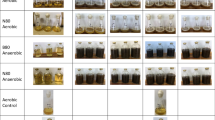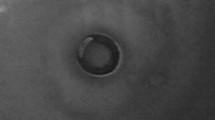Abstract
An anaerobic bacterium (Clostridium sp.) isolated from coal waste solubilized a significant amount of lead oxide (PbO) and to a lesser extent PbSO4, but not Pb‡, PbS, and galena. The rate of Pb dissolution during logarithmic growth of the bacteria in 40 ml of medium containing 3.32 Μmoles of PbO was 0.042 Μmoles/ml/hr. Dissolution of PbO by the bacteria was due to production of organic acids and lowering of the pH of the growth medium. The solubilized metal was bioavailable to the organism as evidenced by lead associated with cell biomass as well as immobilization by a polymer-like substance produced by the organism. These results suggest that under appropriate conditions microbial dissolution of PbO could be significant in the environment.
Similar content being viewed by others
References
Aicken RM, Dean ACR (1978) Lead accumulation by microorganisms. Microbios Letters 5:129–133
Branica M, Konrad Z (eds) (1980) Lead in the marine environment. Pergamon Press, New York, pp vii-ix
Bruland KW, Bertine K, Koide M, Goldberg ED (1974) History of metal pollution in Southern California coastal zone. Environ Sci Technol 8:425–432
Burrows KC, Hulbert MH (1975) Release of heavy metals from sediments: Preliminary comparison of laboratory and field studies. In: Church TM (ed) Marine Chemistry in the Coastal Environment. ACS Symposium Series, American Chemical Society, Washington, DC, pp 382–393
Cole MA (1979) Stabilization of heavy metal sulfides by heterotrophic soil bacteria. Soil Science 127:313–317
Doelman P (1978) Lead and terrestrial microbiota. In: Nriagu JO (ed) The biogeochemistry of lead in the environment. Elsevier/North-Holland Biomedical Press, New York, Part B, pp 345–353
Hobbie JE, Daley RS, Jasper S (1977) Use of nuclepore filters for counting bacteria by fluorescence microscopy. Appl Environ Microbiol 33:1225–1228
Holdeman LV, Cato EP, Moore WEC (1977) Anaerobe Laboratory Manual. Virginia Polytechnic Institute and State University, Blacksburg, Virginia
Kee NS, Bloomfield C (1961) The solution of some minor element oxides by decomposing plant materials. Geochim et Cosmochim Acta 24:206–225
National Academy of Sciences (NAS) (1980) Lead in the human environment. National Academy of Sciences, Washington, DC, p 525
Nriagu JO (1978) Lead in the atmosphere. In: Nriagu JO (ed) The biogeochemistry of lead in the environment. Elsevier/North-Holland Biomedical Press, New York, Part B, pp 137–184
Patterson CC (1974) Interlaboratory lead analyses of standardized samples of seawater. Marine Chemistry 2:69–84
Phelps TJ, Zeikus JG (1984) Influence of pH on terminal carbon metabolism in anoxic sediments from a mildly acidic lake. Appl Environ Microbiol 48:1088–1095
Rickard DI, Nriagu JO (1978) Aqueous environmental chemistry of lead. In: Nriagu JO (ed) The biogeochemistry of lead in the environment. Elsevier/North-Holland Biomedical Press, New York, Part A, pp 219–284
Sillen LG, Martell AE (eds) (1971) Stability constants of metal ion complexes. Spec Publ No. 25, The Chemical Society, London
Smith WH (1981) Air pollution and forests: Interactions between air contaminants and forest ecosystems. Springer-Verlag, New York, p 160
Stevenson FJ, Ardakani MS (1972) Organic matter reactions involving micronutrients in soils. In: J. J. Mortvedt, D. M. Giordano and L. L. Lindsay (eds) Micronutrients in Agriculture. Madison, Wisconsin, Soil Sci Soc Am Inc, pp 79–114
Summers KV, Rupp GL, Gherini SA (1983) Physical-Chemical Characteristics of Utility Solid Wastes. Electric Power Research Institute, Palo Alto, California, EA-3236, RP1487-12. Final Report, September 1983
Tornabene TG, Edwards HW (1972) Microbial uptake of lead. Science 176:1334–1335
Wong PTS, Chan YK, Luxon PL (1975) Methylation of lead in the environment. Nature 253:263–264
Author information
Authors and Affiliations
Rights and permissions
About this article
Cite this article
Francis, A.J., Dodge, C.J. Anaerobic bacterial dissolution of lead oxide. Arch. Environ. Contam. Toxicol. 15, 611–616 (1986). https://doi.org/10.1007/BF01054907
Received:
Revised:
Issue Date:
DOI: https://doi.org/10.1007/BF01054907




